Globally, the majority of education systems are operating in a climate marked by recurrent school closure and reopening cycles for the second consecutive academic year. This threatens sustainable recovery. Mass education disruption has individualand institutional-level effects. There are negative consequences for individual life opportunities which are heightened for marginalized groups; and for macro-economic and societal development at the country level. This policy brief, aimed at G20 countries and donors, recommends a first-open last-close strategy for schools contingent on a strong crisis-sensitive inclusive approach to educational policy and planning for response, recovery, and future prevention. It recommends a ‘twin-track approach’ to address equity concerns, that is, to institute and support mechanisms and policies in education financing, provision, and regulation to boost education resources overall, and to proactively target supplementary resources to the disadvantaged at all levels, i.e., countries, sub-national administrations, communities, schools, and individual groups. At the individual level, the most disproportionately affected students experiencing new pandemic-related vulnerabilities, and students who entered the pandemic in existing vulnerable circumstances, compounded crises, and with intersecting inequities, must be prioritized. The brief considers actions in four key areas: (i) emergency digital distance learning; (ii) education financing; (iii) education management and information systems (EMIS) and micro-planning; and (iv) citizen engagement for accountability and transparency in education.
Challenge
The global education emergency caused by COVID-19 poses a pressing policy problem with immediate and long-term societal and economic effects. Globally, education systems in all but a handful of countries are operating under volatile circumstances for a second consecutive academic year marked by recurrent cycles of school closures and reopening, threatening sustainable recovery. The crisis underscores the centrality of the inalienable right to education, and the obligation on states as the principal duty-bearers under international human rights law to respect, protect, and fulfill that right (UNESCO n.d.).1
Education disruption has institutional and individual-level effects. Institutional-level inequities will affect education systems governance. Individually, inequities will compound on those in existing vulnerable circumstances, emergency and conflict contexts, and facing ‘hard core’ exclusion (Kabeer 2000) due to intersecting characteristics (e.g., relative poverty, gender, race, language, disability, etc.), and those experiencing new pandemic-related vulnerabilities and exclusions.
UNESCO estimated 800 million children had not returned to school or had returned in precarious circumstances by January 2021 (UNESCO 2021), constituting 52% of the global population of children. 2 Data variations make estimating the length of school closures difficult (see Box 1). We estimate that between March 2020 and March 2021, schools were closed globally for an average of 6.7 months (26.8 weeks), due to full nationwide (4 months/16 weeks) and partial (2.7 months/11 weeks) school closures (Figure 1).3 4
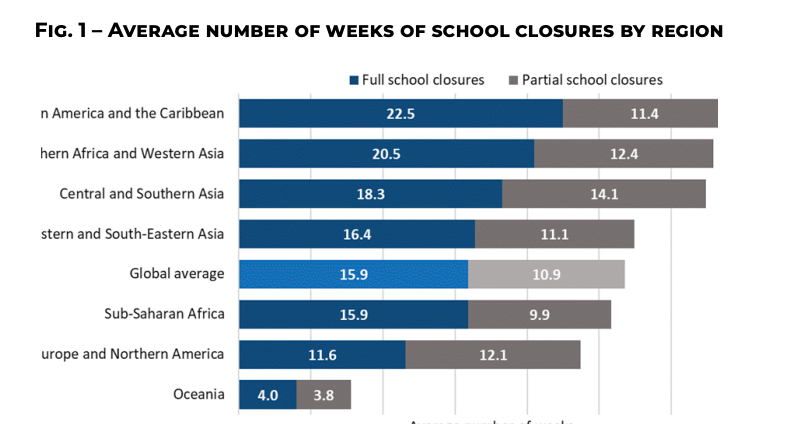 Note: Full school closures refer to instances where all schools were closed at the national level due to COVID-19. Partial school closures refer to school closures in some regions, or for some grades, or with reduced in-person instruction.
Note: Full school closures refer to instances where all schools were closed at the national level due to COVID-19. Partial school closures refer to school closures in some regions, or for some grades, or with reduced in-person instruction.
Source: Authors’ calculations based on UNESCO map on school closures (https://en.unesco.org/covid19/educationresponse) and UIS Education database, accessed 13 March 2021
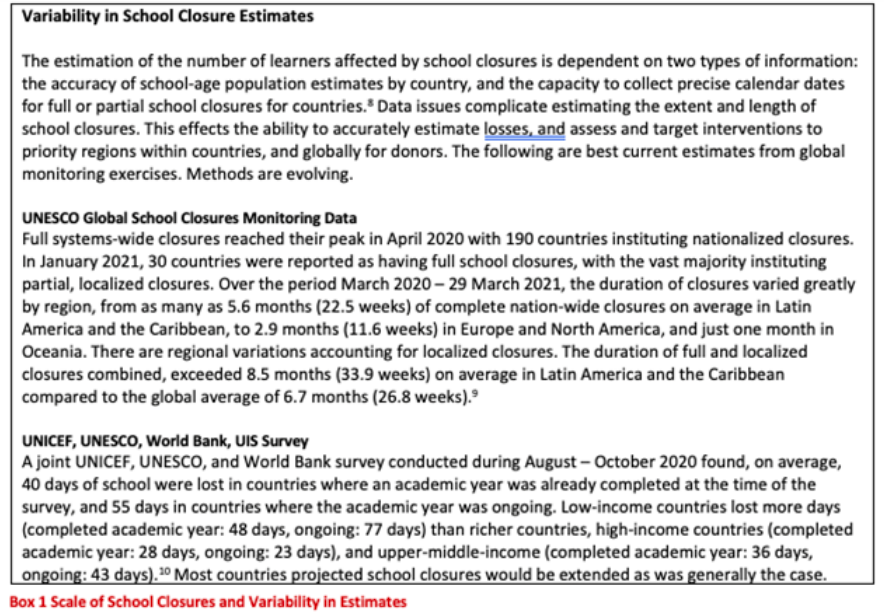
Negative effects of school closures on learning, mental health, social development, child welfare and protection, and lifetime earnings are increasingly documented (see also Box 2).5 At the country level, cumulative costs of lost learning and earnings of this cohort threaten economic and social recovery (Psacharopoulos, Collis, Patrinos, and Vegas 2021). Initial studies from Belgium (Maldonado and De Witte 2020), the Netherlands (Engzell, Frey, and Verhagen 2020), South Africa (Spaull et al. 2021), Switzerland (Tomasik, Helbling, and Moser 2020), the United States (Kuhfeld et al. 2020), and the United Kingdom (Christodoulou 2020), indicate disproportionate effects of learning losses on students from lower socio-economic backgrounds, marginalized groups, and with less educated parents.
COVID-19 losses come on top of severe pre-existing learning gaps between groups of students and across country groups (Box 2, some potential effects). A study of harmonized learning outcomes across 164 countries found that while years of schooling increased on average across all regions between 2000-17, learning outcomes were highly variable across countries and regions, with high-income countries (HICs) outpacing other country groups (Angrist et al. 2021). Globally, it is estimated that 53 out of every 100 children were either out of school or in school but not learning an additional 10 of every 100 children may be added to this total (Save our Future 2020). Learning loss coupled with extended closures may lead to delayed enrolment, lower levels of re-enrolment, and aggravated completion rates, particularly in low-income (LICs) and lower-middle-income countries (LMICs).
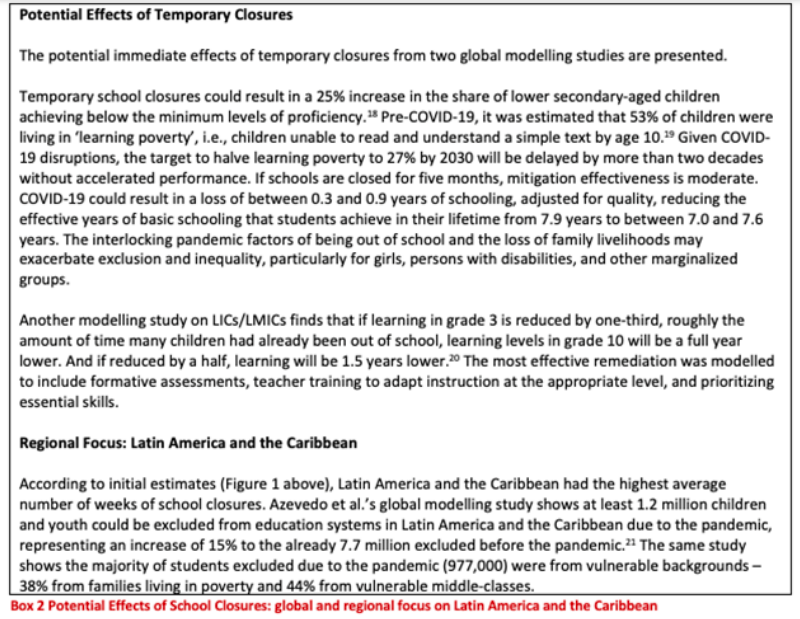
The losses are detrimental to life opportunities. Cumulatively, they will have severe macro-economic effects on countries. A global modeling study of education and earnings data from 205 countries estimates lifetime earnings losses due to COVID-19 school closures could range from US$ 364 billion in LICs to US$ 6.8 trillion in MICs, and US$ 4.9 trillion in HICs globally this amounts to US$ 15.3 trillion (Psacharopoulos, Collis, Patrinos, and Vegas 2021). In short, despite emergency distance education efforts during the initial closure period, substantial lifetime earning losses for this cohort are estimated with negative consequences for longer-term domestic economic growth.
Given the context specificity of the pandemic, this brief does not detail measures on school reopening. Existing guidance from relevant agencies is recommended.6 It presents a macro-level framework with guiding considerations in four suggested areas of action: (i) emergency digital distance learning; (ii) education financing; (iii) education management and information systems (EMIS) and micro-planning; and (iv) citizen engagement for accountability and transparency, to address equity concerns as relevant for G20 countries and G20 OECD DAC donors in supporting recovery.
Proposal
FRAMEWORK FOR EQUITABLE EDUCATION RECOVERY
Education recovery to unlock human potential is contingent on countries instituting pro-equity measures. G20 countries and donors must institute and support mechanisms and policies in education financing, provision, and regulation that proactively boost education resources overall, and target supplementary resources to the most disadvantaged at all levels, i.e., countries, sub-national administrations, communities, schools, and individual groups.7 Pro-equity measures should build on an integrated crisis-sensitive inclusive approach to educational policy and planning for response, recovery, and future prevention, ensuring the needs of all learners and prioritizing vulnerable groups (Boxes 3 and 4).
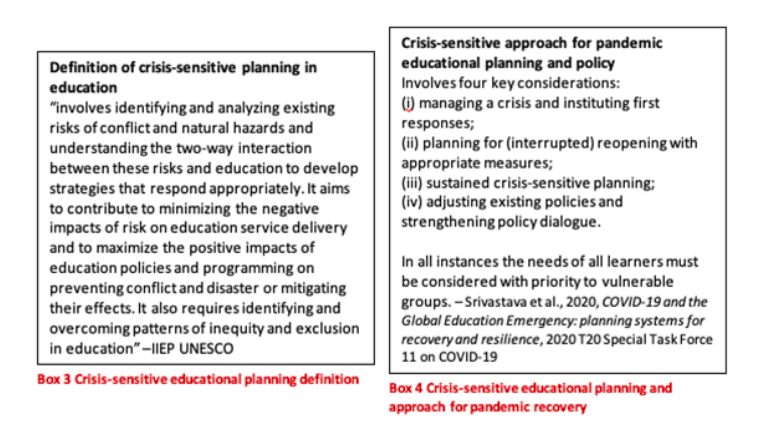
At the institutional level, this brief recommends addressing systems-level issues of governance by: (i) extending system capacities and addressing equity concerns; (ii) being attuned to bidirectional relationships of education with other outcomes; and (iii) through cross-sectoral and multi-stakeholder coordination and collaboration. At the individual level, governments and donors should support those experiencing new exclusions and vulnerabilities caused by the pandemic and those in existing vulnerabilities and compounded crises and with intersecting inequities by redressing individual experiences of disruption for marginalized groups.
GUIDING CONSIDERATIONS
1. NEW EXCLUSIONS AND VULNERABILITIES, COMPOUNDED CRISES, AND INTERSECTING INEQUITIES
The number of children in new vulnerable circumstances is unknown. One study estimates 37,300 to 43,000 children in the United States alone have lost one parent or grandparent due to COVID-19 (Kidman, Margolis, Smith-Greenaway, and Verdery 2021). A new large cohort of children will likely become orphans or suffer family bereavement and other vulnerable circumstances. The intersection of new and existing inequities further jeopardizes access to quality education. Solutions must redress individual experiences of disruption for new and existing marginalized groups.8
Negative effects are compounded for marginalized children and young people in all contexts. They are further heightened in contexts of existing humanitarian crisis where there were socio-economic barriers to education, and education systems were already under strain. Globally, approximately half of all out-of-school primary and secondary-aged children live in crisis-affected countries, yet they have 29% of the total school-age population (INEE 2020a). Furthermore, while girls living in conflict contexts represent just 14% of the world’s primary and secondary school-aged population, they make up more than 25% of out-of-school children and youth (INEE 2020a).
2. BIDIRECTIONAL RELATIONSHIPS AND MULTI-SECTORAL SUPPORT
Education has long been shown to produce positive effects on health outcomes, economic participation, health and well-being, child protection and security, and citizen engagement, among others. Given the many positive outcomes, multi-sectoral support to fill gaps and strengthen systems for recovery is cogent (Box 5, effects in crisis-affected and post-conflict settings).
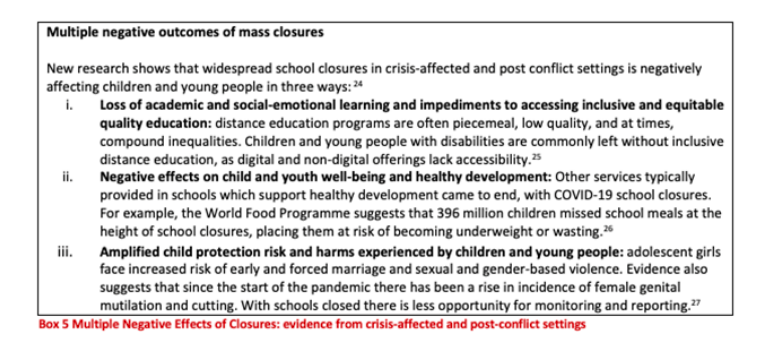
3. CROSS-SECTORAL AND MULTI-STAKEHOLDER PLANNING, PROGRAMMING, AND COORDINATION
Ensuring effective coordination among stakeholders, including other key sectors (e.g., education, health, child protection, labor, etc.), and multi-stakeholder coordination between donors and government and international agencies creates a foundation that will be sustainable before, during, and after a crisis. It may also supplement or share education financing resources. Such planning and coordination can take place through formal existing bodies, or ad-hoc mechanisms, and can help facilitate decision-making as part of COVID-19 recovery efforts, or in the event of future crises (Box 6, examples).
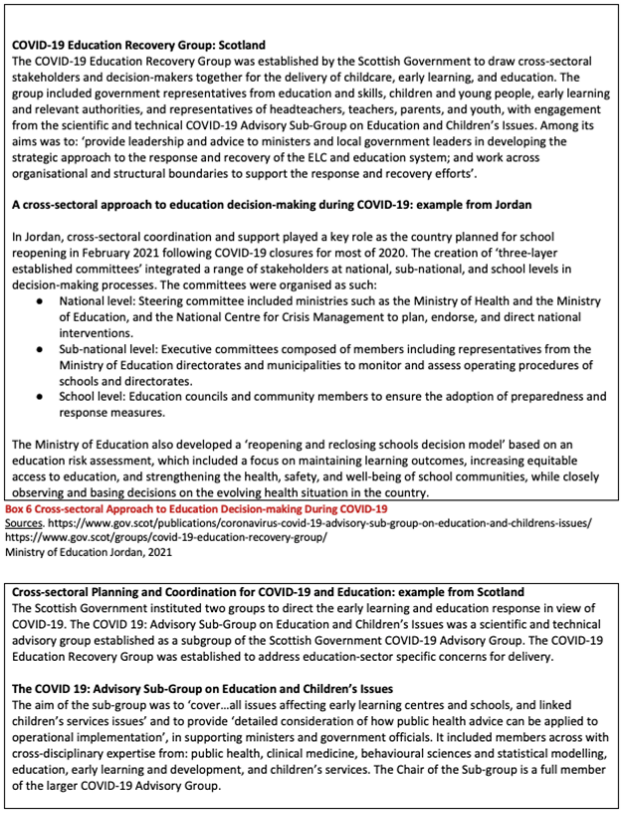
KEY ACTION AREAS
EMERGENCY DISTANCE DIGITAL LEARNING
An estimated 463 million (31%) children who were attending school prior to the pandemic were not reached by digital and broadcast remote learning programs (UNIFEC 2020). Three-quarters were from the poorest households and/or rural areas, a share that is much higher in LICs (UNICEF 2020). Even in HICs, there is a digital divide with limited access in rural or remote areas and less economically advantaged households (Gallagher-Mackay et al. 2021).
A study of seven European countries found parental and child experiences of emergency home-schooling measures with distance digital learning to be negative, with limited support from schools (Thorell et al. 2021). In the best case scenario, as in relatively better-served HICs, emergency mitigation strategies may only compensate between 15% to 60% of losses (Azevedo et al. 2020). In LICs and crisis-affected contexts the outcomes will be far worse. Despite these shortcomings, emergency distance digital learning has been widely adopted to implement some measure of education continuity. Although many countries have taken action to improve connectivity and reach, almost all examples are from upper-middle and HICs, and were shown to have access gaps (Macheroni et al. 2020).
Given low access to the internet (6%) and radio or television (about 50%) in LICs and LMICs (Dreesen 2020; UNICEF 2020), extended disruption of face-to-face learning during the pandemic will exacerbate the learning crisis. The digital divide, within and across countries and social groups, can further aggravate inequities without increased open access to free and affordable services. UNICEF recommends using multiple delivery channels for distance learning, with a combination of digital and non-digital (high and low-tech) approaches (UN 2014).9 Developing material for learners with special needs, supported by the use of, for example, closed captions and audio recordings, live sign language, Braille, and large print is essential.
RECOMMENDATIONS FOR EMERGENCY DISTANCE DIGITAL LEARNING
1. Adapt regular curriculum and pedagogical practices, and introduce accelerated and accessible learning programs for all and specific, targeted initiatives for the most disadvantaged, based on identified needs.
- 2. Diversify modes of delivery, including high and low-tech interventions as appropriate to the context as part of the overall delivery of education.10 To increase access, all materials and infrastructure should be provided without additional cost to households, particularly the most marginalized. Appropriate actions should also include:1. Relevant and accessible distance education integrated with an adapted curriculum: Providing learning materials in adapted formats and languages, and ensuring that content is accessible for all students, especially those in hard-to-reach areas and with people with disabilities. Distributing equipment to facilitate access to distance education where required (e.g. solar radios, school kits, information and communications [ICT] technology).11
- Investing in reducing the digital divide, including bringing together community/collective resources for use by children.
- 2. School reintegrationFostering student reintegration, particularly for students in existing or new vulnerable circumstances such as students with disabilities, girls, including pregnant teenagers and young parents, and children who have needed to work to support themselves or their families.
- Providing extra support to encourage re-enrolment12 and intensive additional targeted learning support once enrolled13
- Implementing school-level policies and invigorate systems-wide allied services and programs to enhance equity and foster recovery 14
- Providing teachers with training and support for school reintegration or continued shorter-term disruptions, and on an adapted curriculum (where it is instituted), and with new variations in learning.
EDUCATION FINANCING
It is critical to protect and increase education sector financing (UNSG 2020). Governments must boost resources for the system overall, and additional resources should be targeted to vulnerable areas and groups. Equity-oriented financing strategies can be implemented by governments through a ‘twin-track’ approach that allocates general funding for an inclusive learning environment for all and targeted funding for the most disadvantaged, with early interventions as quickly as possible (UNESCO 2020).
The Global Education Monitoring Report Team estimates an existing US$ 148 billion annual financing gap for LICs/LMICs to achieve good quality education for all by 2030. Additional costs due to COVID-19-related school closures increased the financing gap to an additional US$ 30 to US$ 45 billion; however, early investments in remedial and re-enrolment programs can reduce the additional cost by as much as 75%.15
Examining education budget allocations can provide insights into the different strategies that governments put in place to tackle the social and economic costs of the pandemic. G20 countries are balancing public budgets against competing priorities. Early indications for G20 countries show variable patterns, with a number of countries announcing financing cuts (Box 7, preliminary analysis).16 Further concerted analysis is required, but if early indications persist, system recovery will be threatened by inadequate resourcing.17
Early evidence indicates that public education budgets have been reduced in two-thirds of LICs and LMICs since the start of the pandemic (UNESCO and World Bank 2020). Official development assistance for education remains low and unpredictable. While there has been a slow upward trend in humanitarian financing of education since 2012, it remains at just 2.6% (INEE 2020b), which is significantly lower than the 10% target of the European Union (EU 2017). While humanitarian aid to education has increased marginally overall, many countries are being left behind 11 of 30 countries identified as ‘forgotten crises’,18 launched a humanitarian appeal for education, with 10 of them receiving less than 50% of the funding required. Of the 10, six were located in sub-Saharan Africa.19 The implications for the education of children and young people in these forgotten crises were dire even before the COVID-19 pandemic. Without increased and predictable multi-year funding for education, their futures, and their countries, will be bleak.
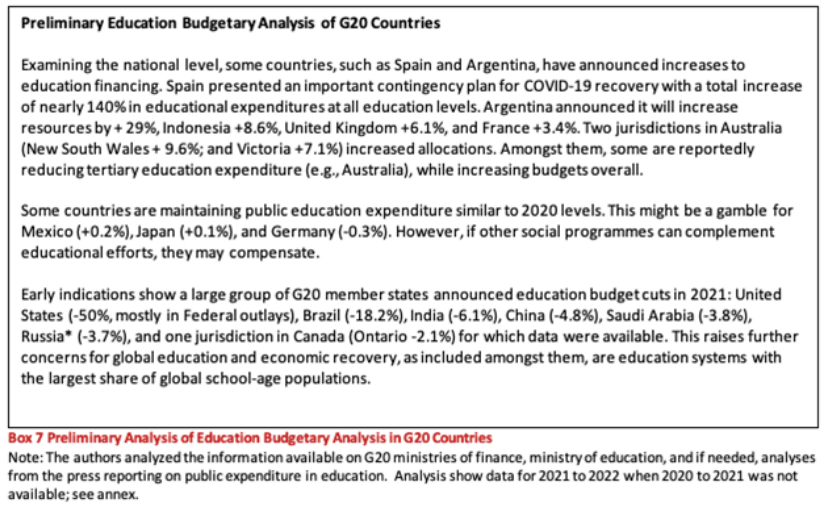
RECOMMENDATIONS FOR EDUCATION FINANCE
3. Adopt a ‘twin track’ strategy that protects and boosts education resources for the system overall and allocates supplemental resources to targeted areas and groups, ensuring specific earmarked resources for existing and marginalized groups.
- Commit longer-term resources to education to account for medium to long-term effects of education disruption
- Consider cross-sectoral resources and multi-sectoral financing strategies to supplement education budgets where and if appropriate
- Decentralize fund management to the lowest administrative level possible so that spending can best reflect local priorities and expectations
4. Donors should increase and protect humanitarian and development aid to education, with cross-sectoral and multi-stakeholder financing, particularly if domestic education budgets are reduced. Aid should be flexible, predictable, multi-year, and equitable to ensure that education needs in forgotten crises are met.
- Include capacities for humanitarian donors to fund structural challenges to equity20
- Support crisis-affected contexts and education for displaced children and youth
- G20 donors should match EU commitment to allocate 10% of total humanitarian aid to education
EMIS AND MICRO-PLANNING
Reliable, accessible, and relevant data enable informed decisions in crises and during recovery. The pandemic highlighted gaps in existing EMIS for rapid crisis response (Box 8, EMIS definition) (UNESCO 2008). Rethinking and adapting data architectures and monitoring systems to spur recovery require more frequent and flexible data collection exercises beyond the routine21. Adaptations should institute comparable data collection and analysis systems across geographic units so as to factor in local contexts. This can ensure that the needs of vulnerable students and communities can be quickly identified for decision-making processes, and to implement targeted responses.
Accessible, relevant, comparable, and transparent public data are needed to target responses and boost and mobilize resources for the most marginalized. The 2021 World Development Report details the role of such data to: (1) improve service delivery, (2) prioritize scarce resources, and (3) hold governments accountable and empower individuals (World Bank 2021). However, to realize the potential of data for the public good, addressing inadequate coverage, timeliness, frequency, geospatial gaps, lack of granularity, accuracy and comparability must be considered, alongside safeguarding data against misuse, particularly in an era of disinformation (World Bank 2021).
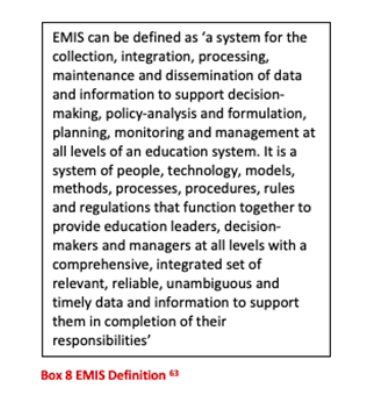
The safeguards of the UN Fundamental Principles for Official Statistics provide a touchstone to collecting, managing, and using key data and cover scientific standards and professional ethics; the need of independence of political pressures to collect, process, store, and disseminate statistical data; confidentiality; utility, accountability, and transparency (UN 2014). Increasingly, there are calls for governments and international agencies to provide open data as the default modality to strengthen accountability and citizen engagement. 22
Education monitoring exercises should be coordinated with local education authorities and, when relevant, humanitarian partners to avoid duplication. The UNESCO Institute for Statistics suggests the following three measures for relevant data collection regarding education disruption and the pandemic (UIS 2020):
1. rapid data collection formats focusing on key indicators and sampling schools and students rather than the full population;
2. monitoring equity by over-representing vulnerable students (e.g., girls, students in poverty, students with special needs, minority or linguistic groups); 3. frequent low-stakes learning measurement.
Instituting targeted education recovery interventions will depend on a comprehensive understanding of gaps caused by education disruption alongside micro-planning exercises to identify specific communities and groups of students that are disproportionately affected. Geospatial data can play an integral role in a pro-equity micro-planning approach by enabling the identification of micro-level profiles of exclusion. Relevant geospatial data can be collected by governments and a range of partners as part of rapid assessments. In cases where these activities are not centralized, the data should be made available to ministries of education for planning purposes. Proactive measures can be taken by ministries of education for data curation and storage, such as creating data portals or open repositories for independent data to be collated. Longer-term, governments can improve EMIS by including information on context-specific risks and vulnerable populations to inform planning for safety, resilience, and social cohesion (IIEP-UNESCO; PEIC; IBE-UNESCO 2015). Meaningful efforts to build feedback loops with communities for ongoing engagement are required.
Despite the gaps, emergencies may provide an opportunity to strengthen EMIS than was in place before the crisis (IIEP-UNESCO 2010). This requires strong national data policies to integrate data collection and monitoring exercises to prepare for recovery and future crises, and could involve the use of harmonized and aligned tools by governments and partners for any data produced.
RECOMMENDATIONS FOR EMIS AND MICRO-PLANNING
5. Rethink and adapt existing EMIS data architectures and monitoring systems to spur recovery and strengthen education systems
- Extend capacities of decentralized data collection with a feedback loop to higher administrative-level policymakers and planners and integrate into a centralized data system
- Implement comparable, more frequent, and flexible data collection exercises beyond the routinely scheduled ones
- Employ measures to produce open data and to safeguard data for public use and for the public good
6. Proactively create data structures and exercises to identify marginalized areas and groups
- Disaggregated data on vulnerable learners are often fragmented or unavailable, making crisis response for these groups more difficult. Collect and update data on the most marginalized learners as a necessary first step to mitigate existing disparities and facilitate inclusive and equitable planning (UNESCO 2021b)
- Create geospatial datasets that record the location of schools, and other relevant entities23 that might be useful for educational micro-planning during and beyond emergency situations
- Undertake a systematic mapping of the impact of COVID-19 and related school closures on different groups of students to support the development of targeted outreach and support measures (UNESCO 2021b). This can be done as part of a joint sector review or education sector analysis, or even as part of an annual review of the implementation of a country’s education sector plan.
CITIZEN ENGAGEMENT FOR ACCOUNTABILITY AND TRANSPARENCY IN EDUCATION
A multi-faceted approach to accountability, in which citizen engagement is one key aspect, is needed to foster shared responsibility, heightened in times of extended education disruption.24 Extending open government initiatives, along its three principles transparency, accountability, and citizen engagement25 can bolster education service delivery commitments for recovery (Huss and Keudel 2020). In particular, citizen engagement can spur government accountability regarding education commitments on the one hand, and provide critical information on gaps to administrators and policymakers on the other. Governments providing accessible open data with feedback loops on data reporting is one way to strengthen citizen engagement for transparency and accountability.
Community participation is a foundation standard for education.26 Engaging parents, teachers, learners, and school leaders in decision-making can help ensure that selected measures address the evolving needs of school communities. This will enable better monitoring of progress, increase transparency, and through citizen engagement, enable households with greater access to information for better decision-making. However, as marginalized groups may be excluded from general calls to participation, it is crucial that targeted initiatives are implemented to ensure their engagement is institutionalized. A social or citizen audit can be key a mechanism to increase citizen engagement in education (Box 9, example from India). Creating platforms of state-citizen interaction that can facilitate government response and addressing grievances is key.
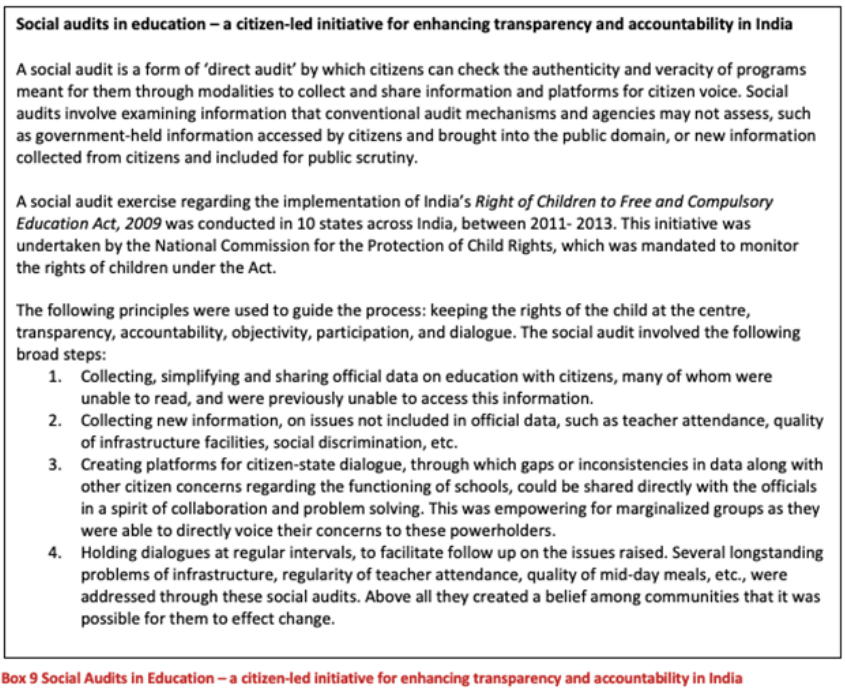
RECOMMENDATIONS FOR CITIZEN ENGAGEMENT FOR ACCOUNTABILITY AND TRANSPARENCY
7. Implement targeted open and public initiatives to ensure participation from marginalized groups. They should be institutionalized in the formal decision-making and educational planning processes.
- Institute processes of data verification by the public and citizen engagement to facilitate more equitable planning and to find more relevant solutions for specific groups.
- Institute grievance mechanisms for accountability towards citizens
- Create a platform for communication and interaction amongst citizens and cross-sectoral stakeholders.
- Ensure a regulatory or legal framework for citizen participation27.
CONCLUSION
G20 countries and donors must institute and support mechanisms and policies in education financing, provision, and regulation that proactively boost education resources overall, and target supplementary resources to the most disadvantaged at all levels. Pro-equity measures should build on an integrated crisis-sensitive inclusive approach to educational policy and planning. At the institutional level, policies should address systems-level issues of governance by (i) extending capacities and addressing equity concerns, (ii) being attuned to bidirectional relationships of education with other outcomes; and (iii) through cross-sectoral coordination and collaboration. At the individual level, governments and donors should support those experiencing new exclusions and vulnerabilities caused by the pandemic and those in existing compound crises and with intersecting inequities by redressing individual experiences of disruption for marginalized groups.
ACKNOWLEDGEMENTS
The author team would like to thank Blair Glencorse, Executive Director, Accountability Lab and Priyadarshini Joshi, Senior Project Officer (Research), Global Education Monitoring Report, UNESCO for their comments to the draft.
NOTES
1 UN ECOSOC. 1999. “Implementation of the International Covenant on Economic, Social, and Cultural Rights. General Comment No. 13 (Twenty-first Session, 1999).” The Right to Education (Article 13 of the Covenant). Committee on Economic, Social, and Cultural Rights. Twenty-first Session, November 15-December 3, 1999. E/C.12/1999/10. December 8, 1999.
2 The school-age population for ISCED 0 to 3 on which are based the estimates is 1,524,845,235.
3 Authors’ calculations, using UNESCO map on school closures (http://en.unesco.org/covid19/educationresponse) and UIS Education database, accessed 13 March 2021. Definitions and methodology can be found here https://en.unesco.org/sites/default/files/en_methogological_note_-_unesco_map_on_covid-19_caused_school_closures_reopening_final.pdf
4 UNESCO (2021).
Global averages are difficult to estimate since the school calendar and number of days in school vary across countries. Furthermore, number of days and contact hours are two different measures. For this reason, it is important that local education authorities conduct localised assessments and data collection to more accurately estimate the true time of in-person instruction lost.
5 See Viner et al., 2020 for a systematic review. Specific studies are referenced throughout the brief as appropriate. Research in all areas is not equally well-developed. Comparative studies in a number of areas are emerging and work is urgently required. For example, child well-being and protection are under-addressed (INEE & ACPHA, 2020).
6 See for example, the Framework for Reopening Schools https://www.unicef.org/documents/framework-reopening-schools and the Supplement to Framework for reopening schools: emerging lessons from country experiences in managing the process of reopening schools jointly developed by UNESCO, UNICEF, World Bank, WFP, and UNHCR https://en.unesco.org/news/new-supplement-framework-reopening-schools.
7 Adapted from SDG Indicator 4.5.3 ‘existence of funding mechanisms to reallocate education resources to disadvantaged populations’.
8 This includes but not limited to: Indigenous and under-served communities, girls, socio-economically vulnerable, racialized groups, internally displaced persons and refugees, linguistic, cultural, and other minorities, and students with disabilities.
9 Examples include special radio and television broadcasts, SMS messaging, telle-helplines, and take-home print-based packages for guided instruction.
10 This may draw on radio, TV, cellular on internet, and modalities accessible for people with disabilities
11 For more on programmatic options and activities to promote equity in crisis contexts, see Booklet 4: Programming: How do we get there? (IIEP-UNESCO; PEIC; UNESCO IBE, 2015).
12 E.g., waiving school fees; school feeding programs; health support
13 For example, targeted tutorial support at no additional cost
14 E.g., waiving school fees; re-introducing school feeding programs; health, counselling, diagnostic, therapeutic support, and extending programs outside of the regular academic year.
15 GEM Report.Act now: reduce the impact of COVID-19 on the cost of achieving SDG4. https://en.unesco.org/gem-report/COVIDcostSDG4
16 Authors’ calculations based on publicly available data. These are not final estimates and are likely to be revised. Data available in: https://bit.ly/35Kny4g
17 Given formal budgeting processes and data releases, these indications are preliminary and not fully clear at the time of writing.
18 Forgotten crises are taken from the European Civil Protection and Humanitarian Aid Operations index. This is based on four criteria: 1. vulnerability index, 2. media coverage, 3. public aid per capita, and 4. qualitative assessment based on regional experts.
19 European Civil Protection and Humanitarian Aid Operations index.
20 E.g. teacher salaries, or pre-service teacher training in crisis-affected areas.
21 For example, rapid response surveys and interviews; targeted collection on marginalized groups; baseline and follow-up learning monitoring; psycho-social effects of education disruption, etc.
22 https://opendatacharter.net/
23 For example, access pathways to school, water points, zones affected by droughts, food insecurity, etc.
24 GEM Report 2017/18 on accountability
25 https://etico.iiep.unesco.org/en/open-budget-learning-open-school-platform-donetsk-oblast-ukraine
26 Inter-agency Network for Education in Emergencies (INEE). (2010a). INEE Minimum Standards for Education: Preparedness, response, recovery. https://inee.org/resources/inee-minimum-standards
27 E.g., regulations for public consultations, petitions, grievances
REFERENCES
Angrist N. et al., (2021), “Measuring human capital using global learning data”, Nature, vol. 592, pp. 403-08 https://doi.org/10.1038/s41586-021-03323-7
Azevedo J.P. et al. (2020), Simulating the Potential Impacts of COVID-19 School Closures on Schooling and Learning Outcomes. A Set of Global Estimates, Policy Research Working Paper 9284, World Bank Group, June https://openknowledge.worldbank.org/bitstream/handle/10986/33945/Simulating-the-Potential-Impacts-of-COVID-19-School-Closures-on-Schooling-and-Learning-Outcomes-A-Set-of-GlobalEstimates.pdf?sequence=1&isAllowed=y
Bhaty K., (2013), Guidelines for School Social Audits, Policy Brief, Centre for Policy Research, October https://cprindia.org/sites/default/files/policy-briefs/Guidelines%20for%20School%20Audits%20final.pdf
Christodoulou D., (2020), “Baseline Secondary Writing: have Year 7 pupils gone backwards?”, The no more marking blog, September https://blog.nomoremarking.com/baseline-secondary-writing-have-year-7pupils-gone-backwards-5497ac10b894
Dreesen T. et al., (2020), Promising practices for equitable remote learning: Emerging lessons from COVID-19 education responses in 127 countries, UNICEF https://www.unicef-irc.org/publications/pdf/IRB%202020-10%20CL.pdf
Engzell P., A. Frey, and M.D. Verhagen, (2020), Learning Loss Due to School Closures During the COVID-19 Pandemic, 29 October https://osf.io/preprints/socarxiv/hf32q/
European Union, (2019), Education and Training. Monitor 2019, Luxembourg, Publications Office of the European Union https://ec.europa.eu/education/sites/default/files/document-library-docs/volume-1-2019-education-and-training-monitor.pdf
Gallagher-Mackay K. et al., (2021), “COVID-19 and Education Disruption in Ontario: Emerging Evidence on Impacts”, ScienceTable, 16 June https://openknowledge.worldbank.org/bitstream/handle/10986/33945/Simulating-the-Potential-Impacts-of%20COVID-19-School-Closures-on-Schooling-and-Learning-Outcomes-A-Set-of-GlobalEstimates.pdf?sequence=1&isAllowed=y
Huss O. and O. Keudel, (2020), Open government in education: clarifying concepts and mapping initiatives, UNESCO IIEP https://unesdoc.unesco.org/ark:/48223/pf0000373142
IIEP-UNESCO (UNESCO International Institute for Educational Planning), (2010), Guidebook for planning education in emergencies and reconstruction, Paris, UNESCO-IIEP, p. 156
IIEP-UNESCO; PEIC; IBE-UNESCO, (2015), Incorporating safety, resilience, and social cohesion in education sector planning, Paris, UNESCO-IIEP http://education4resilience.iiep.unesco.org/sites/default/files/booklets/1_planning_en.pdf
Inter-agency Network for Education in Emergencies (INEE), (2020a), 20 years of INEE: Achievements and Challenges in Education in Emergencies, New York, INEE https://inee.org/resources/20-years-inee-achievements-and-challenges-education-emergencies
Inter-agency Network for Education in Emergencies (INEE), (2020b), Coronavirus (COVID-19) resources, New York, INEE https://inee.org/covid-19/resources
Kabeer N., (2000), “Social exclusion, poverty and discrimination: Towards an analytical framework”, IDS Bulletin, vol. 31, no. 4, pp. 83-97
Kidman R., R. Margolis, E. Smith-Greenaway, and A.M. Verdery, (2021), “Estimates and Projections of COVID-19 and Parental Death in the US”, JAMA Pediatrics, https://jamanetwork.com/journals/jamapediatrics/fullarticle/2778229
Kuhfeld M., B. Tarasawa, A. Johnson, E. Ruzek, and K. Lewis, (2020), Learning during COVID-19: Initial findings on students’ reading and math achievement and growth, Brief, Collaborative for Student Growth, NWEA https://www.nwea.org/content/uploads/2020/11/Collaborative-brief-Learning-during-COVID-19.NOV2020.pdf
Maldonado J.E. and K. De Witte, (2020), The effect of school closures on standardised student test outcomes, Discussion paper series dps20.17, Faculty of Economics and Business, Ku Leuven, September https://lirias.kuleuven.be/3189074?limo=0
Mascheroni G. et al., (2021), La didattica a di stanza durante l’emergenza COVID-19:l’e sperienza italiana, European Commission OSSCOM – UNICEF, February https://www.unicef-irc.org/publications/pdf/la-didattica-a-distanza-durante-l%E2%80%99emergenza-COVID-19-l’esperienza-italiana.pdf
Psacharopoulos G., V. Collis, H.A. Patrinos, and E. Vegas, (2021), “The COVID-19 Cost of School Closures in Earnings and Income across the World”, Comparative Education Review, vol. 65, no. 65
Save our Future, (2020), Averting an education catastrophe for the world’s children, White paper, October https://reliefweb.int/sites/reliefweb.int/files/resources/White-Paper-FINAL.pdf
Spaull N. et al., (2021), NIDS-CRAM Wave 4 Synthesis Report, https://cramsurvey.org/wp-content/uploads/2021/05/1.-Spaull-N.-Daniels-R.-C-et-al.-2021-NIDS-CRAM-Wave-4-Synthesis-Report..pdf
Thorell L.B. et al., (2021), “Parental experiences of homeschooling during the COVID-19 pandemic: differences between seven European countries and between children with and without mental health conditions”, European Child and Adolescent Psychiatry, vol. 1, no. 3 https://doi.org/10.1007/s00787-020-01706-1
Tomasik M.J., L.A. Helbling, and U. Moser, (2020), “Educational Gains of In-Person vs. Distance Learning in Primary and Secondary Schools: A Natural Experiment During the COVID-19 Pandemic School Closures in Switzerland”, International Journal of Psychology, Institut für Bildungsevaluation, September https://www.researchgate.net/publication/344890852_Educational_Gains_of_In-Person_vs_Distance_Learning_in_Primary_and_Secondary_Schools_A_Natural_Experiment_During_the_COVID-19_Pandemic_School_Closures_in_Switzerland
UIS, (2020), “The Need to Collect Essential Education Data During the COVID-19 Crisis, Fact Sheet No. 58. UIS/2020/ED/FS/58”, Montreal, UIS, May http://uis.unesco.org/sites/default/files/documents/fs58-need-for-essential-education-data_0.pdf
UNESCO, (n.d.), Right to Education – State Obligations and Responsibilities, Paris, UNESCO https://en.unesco.org/themes/right-to-education/state-obligations
UNESCO, (2008), Education for All by 2015: will we make it?, EFA global monitoring report, Paris, UNESCO
UNESCO, (2020), Global Education Monitoring Report 2020. Inclusion and education. All means all, Paris, UNESCO, p. 20 https://unesdoc.unesco.org/ark:/48223/pf0000373718.locale=es
UNESCO, (2021a), UNESCO figures show twothirds of an academic year lost on average worldwide due to Covid-19 school closures, 25 January, Paris, UNESCO https://en.unesco.org/news/unesco-figures-show-two-thirds-academic-year-lost-average-worldwide-due-covid-19-school
UNESCO, (2021b), Building back resilient: How can education systems prevent, prepare for and respond to health emergencies and pandemics?, Issue note no 1.3, Paris, UNESCO, January https://unesdoc.unesco.org/ark:/48223/pf0000375278
UNESCO and the World Bank, (2021), Education Finance Watch 2021 https://unesdoc.unesco.org/ark:/48223/pf0000375577.locale=en
United Nations, (2014), Fundamental Principles of Official Statistics, (A/RES/68/261 from 29 January 2014) https://unstats.un.org/unsd/dnss/gp/fundprinciples.aspx
United Nations, (2020), Education during COVID-19 and beyond, Policy Brief, August https://www.un.org/development/desa/dspd/wp-content/uploads/sites/22/2020/08/sg_policy_brief_covid-19_and_education_august_2020.pdf
United Nations Children’s Fund and International Telecommunication Union, (2020), “How many children and young people have internet access at home? Estimating digital connectivity during the COVID-19 pandemic”, New York, UNICEF, New York
World Bank, (2021), 2021 World Development Report – Data for better lives, Washington DC, World Bank https://www.worldbank.org/en/publication/wdr2021








